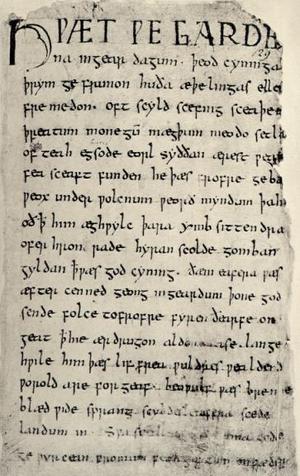Beowulf is an epic poem written in the 8th Century by a Pagan warrior-poet. Reinterpreted in the 11th Century by two distinct Christian monks, this poem has both Pagan and Christian religious motifs throughout the writing. Beowulf is centrally a transitory literary piece from the Pagan era to a Christian one and the text offers the only glimpse of Nordic culture during a Paganistic era. A conflict arises in the poem when the original text is rewritten in a different time period and context. In Beowulf, a Pagan tale has been translated by Christian monks to represent the Christian themes and motifs of their times. So, does a Christian interpretation take away from the original Pagan message? The answer is yes as the conclusion of Beowulf has been altered to favour a Christian message. As stated by Thayer in his article on Beowulf “Resolving the ‘Double Curse’ of the Pagan Hoard in Beowulf,” “the original story is passing from Pagan into Christian hands” (174). And nowhere is the transition of Beowulf from Pagan hands into Christian ones more obvious than in the sections dealing with the Pagan curse which is placed on the treasure hoard. Here, a Pagan curse on an ancient king’s burial mound is removed through the Christian God’s intervention. Beowulf retains many Pagan myths, but the removal of the curse on the treasure hoard is heavily Christian influenced and alters the poem’s central message of heroism and valour. The removal of the curse and Pagan motifs including a dragon and the poem’s central protagonist, Beowulf, is an attempt by the transcribers to show the power and dominance of the Anglo-Saxon Christian religion over the Nordic Paganistic one.
The curse on the earth barrow, the appearance of the dragon, and the central hero, Beowulf, are each Paganistic in origin, but their removal is given credit to Christian influence. Examples of the original Paganistic influences can be seen in Beowulf including the curse that is placed on the treasure-lodge. As stated by Tanke in his article “Beowulf, Gold-Luck, and God’s Will,” the curse in Beowulf “is a protective spell laid upon a sacrificial treasure” that is created within a “Pagan-Germanic context” (358). In regards to the curse on the burial chamber: “That huge cache, gold inherited from an ancient race, was under a spell.” Also, the spell is created by an ancient Norse tribe that is descended from “a highborn [Pagan] race” (2235-3049). The curse is definitively Pagan in origins, as the casting of spells on burial mounds and treasure hoards is a part of Pagan culture, and its occurrence is repeated often in the text. Yet, the removal of Pagan curses requires Pagan magic to counter the original sorcery and not Christian interference. Instead, within Beowulf, the Christian religion removes the curse: “That huge cache, gold inherited from an ancient race, was under a spell – which meant no one was ever permitted to enter the ring-hall unless God Himself…permitted” (3051-3056). This addition of an all powerful God who influences characters and events is in sharp contrast to the many other Pagan influences in the text and not part of the original passages. A Nordic mythological creature, a dragon, or “sky-winger,” is also removed by Christian interference as stated by the readings (2234).
The dragon in the earlier passages of Beowulf is an example of a Pagan element that is an extension of the curse, which is attracted to the Pagan sorcery on the barrow. The dragon’s death is caused by the Christian God’s influence in the story. This mythical creature is a Pagan motif that occurs often in other Norse writings and dragons often protect cursed treasure. There is an example of a Pagan dragon in Norse poetry found ina reference withinthe 5th Century Norse poem “Sigurd the Dragon Slayer.” The passages describe the dragon as the central antagonist: “I [Sigurd] will be able to work great deeds if courage helps and if you want me to kill this dragon” (59). A minor Nordic character also from the 5th Century, known as Oli, is represented as having killed a dragon, as written in “The History of the Danes:” The reference to a dragon is found in the line: “[Oli’s] fight with the dragon and the winning of treasure” (160). The appearance of dragons that fight with Pagan heroes is a common conflict that unravels in Norse mythology. Evil creatures often protect cursed treasure in Pagan literature including Beowulf. For example, Grendel and his mother protect ancient heirlooms in a cursed water cave (1557). The dragon in Beowulf is one of three antagonists in the poem and is Pagan in origin. Its death at Beowulf’s hands is, however, given Christian credit: “God…ordains who wins or loses” (2875). This passage, in reference to the battle between Beowulf and the dragon, is given a Christian tint and alters the original Pagan message of heroic adventure in favour of one of fate. As well, the theme of heroic adventure, bravery, and weregild, or warrior honour, is replaced by a theme of powerlessness: “God judged…[what] would rule” (2858). Thus, the original Pagan messages are distorted by the Christian monks who have chosen a Christian conclusion that changes the poem’s original Pagan text.
References to the weregild occur often in Beowulf, for example “A warrior will sooner die than live a life of shame”(2890).The thief, who has Christian protection, removes the Pagan curse showing the conflicting messages within the story. The Christian God favours the thief by allowing the intruder into the cursed barrow to remove a single golden goblet. The Pagan code of conduct would punish the desecration of a Pagan burial mound. The direct interference by the Christian God, using a thief to remove the goblet from the cursed earth-barrow, nullifies the original Pagan curse and sets the poem up to promote the power of Christianity. Tripp, a scholar of medieval literature, states from his article “Lifting the Curse on Beowulf” that the curse itself is preventative in nature only, and not prohibitive, which simply means that the Pagan curse is imperfect and conquerable (2). Thus, this imperfect protection placed on the treasure mound is penetrated by an intruder with “thief’s wiles” who has the Christian God’s permission to enter: “So may a man not marked by fate easily escape exile and woe by the grace of God” (2291-2294). The thief has found God’s approval to remove the Pagan curse and the Christian God has direct influence in the thief’s entry into the hoard. More evidence of the direct intervention of the Christian God begins: “God himself…allowed some person pleasing to Him…to open the hoard” (3050). This last passage shows the Christian God’s generous treatment of those in “exile and woe” as God allows the thief to benefit from his theft (2293). The Pagan traditions would punish such actions. As stated by Tanke in “Beowulf, Gold-Luck, and God’s Will” in reference to the cursed barrow, “God is the ultimate owner of the treasure” (364). The original Pagan messages and influences are lost in attempt to promote the power of a Christian God who favours thieves. The release of the dragon, once the curse is removed, leads to the death of Beowulf, the central Pagan hero in the writings. The death of the hero signals the end of the original Pagan influences in the story. These influences are replaced by a Christian parable which states that God is the one who decides fate and it is He who has caused the removal of the curse, the death of the dragon, and Beowulf’s death.
The thief enters the barrow and removes the curse on the treasure. This signals the beginning of the Christian influences in the text. The deaths of both the dragon and the poem’s central protagonist, Beowulf, deny the possibility of a Pagan message. The Pagan themes central to Nordic writing such as heroism, protection of ones’ clan, and the continuation of a blood feud or cycle of violence, are replaced by Christian ideals. Christian motifs of destiny, protection of the weak and the undeserving, and the powerlessness of man in face of an all-knowing God are used to replace the original Pagan messages. There are allusions to the continuing blood feuds between the many Nordic clans after Beowulf’s death as seen in this example: “Now war is looming over our nation…[now] that the king is gone” (2911-2914). Yet the Pagan themes are dominated by Christian ones, as seen in the lines involving Beowulf’s death: “To the everlasting Lord of all, to the King of Glory, I [Beowulf] give thanks that I behold this treasure here in front of me” (2794-2797). Beowulf is a Pagan hero who completes countless feats in service of his people to be immortalized in epic poetry following the tradition of Pagan culture. Another reference to the Christian influence, however, is during Beowulf’s death: “Beowulf fought and fate denied him” (2574). Beowulf is powerless to fight God’s plan and so his death is credited to the Christian God’s desire. An allusion to Beowulf’s afterlife is also Christian in tone: “it was no easy thing to have to give ground like that and go unwillingly to inhabit another home in a place beyond” (2587-2590). In Pagan culture death is final, as there is no afterlife in Pagan beliefs. Tanke restates this point when he states “his fate is death…[in a] Pagan-Germanic context” (358-370). Beowulf’s death ends his physical and spiritual existence forever and there will be no afterlife despite this Christian allusion to one. The death of the central Pagan hero is coloured by Christian influences to conclude the poem as a Christian parable with the message that each of the events in the story has been pre-destined by God and that He is all powerful. Beowulf is destined for an afterlife and gives thanks to an unseen God, which further exemplifies Christian motifs of the original Pagan text.
As can be seen in the many examples in this Nordic text, Beowulf has been reinterpreted by Christian scholars to diminish the Pagan influences in favour of Christian ideals. Almost entirely absent of Christian references in the first two thirds of the poem, the final third of the narrative is heavily influenced by Christian monks who reinterpreted the text in the 11th Century. The loss of pages from the original text over the passage of time could contribute to the Christian influences in Beowulf. The major reason, however, for so many Christian references is to show the domination of Christianity over Paganism. Attributing the death of Beowulf and the dragon to the Christian ideal of fate is an attempt to display the power of Christianity in an originally Pagan tale. God removes the curse on the barrow, showing that the action in the poem is initiated by Christian means and not Pagan ones. The final curse that is placed on Beowulf’s own burial chamber by Pagan chiefs alludes to the powerlessness of Pagan sorcery in the face of an all powerful God: “The highborn chiefs who had buried the treasure declared it until doomsday so accursed” (3069-3070). This second curse, of course, will be removed by God Himself on doomsday as predicted within the Christian Book of Revelations.
Works Cited
Christ, Carol T., Alfred David, Barbara K. Lewalski, George M. Logan et al.. The Norton
Anthology of English Literature. 8th ed. New York: W. M. Norton & Company, 2006. 26-97. Print. The Major Authors.
Cooke, William. “Who Cursed Whom, and When? The Cursing of the Hoard and Beowulf’s
Fate.” Medium Aevum 76.2 (2007): 207-24. Print.
Tanke, John. “Beowulf, Gold-Luck, and God’s Will.” Studies in Philology 99.4 (2002): 356-79.
Print.
Thayer, J D. “Resolving the ‘Double Curse’ of the Pagan Hoard in Beowulf.” Explicator 66.3
(2008): 4-5. Print.
The Mode and Meaning of Beowulf (London: Athlone Press, 1970) and A. J. Bliss, “Beowulf
Lines 3074-3075,” in Mary Salu and Robert T. Farrel, eds., J.R. r. Tolkien, Scholar and
Storyteller, Essays in Memoriam (Ithaca and London, 1979), pp.41.63.


